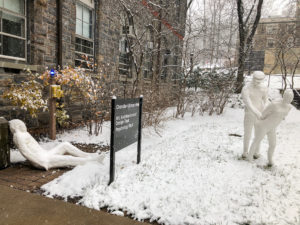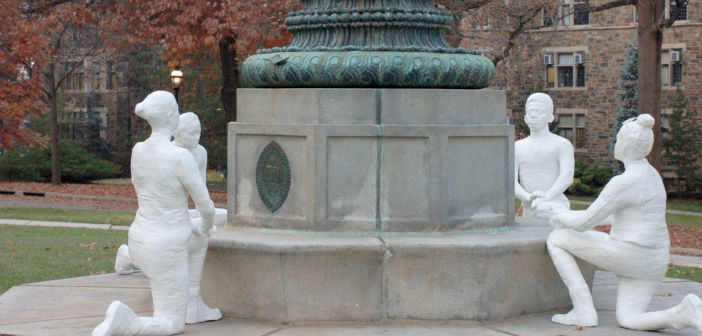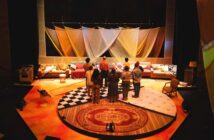Over the past few weeks, sculptures created by student artists have been appearing all over campus to make statements about either political views or the existing art on campus.
These white plaster sculptures, which take on the form of life-size human figures, are a part of a project in the Sculpture I class taught by art professor Lucy Gans.
Student artists were asked to pick a stance on a social or political issue they felt passionate about and use human figures to create a sculpture scene to serve as a tangible artistic representation of their viewpoints.
Students who found it difficult to take a stance on a political or social issue were allowed to instead use their plaster sculptures to comment on how existing campus sculptures interact with the community.
The project was originally inspired by American artist, photographer and sculptor George Segal, whose sculpture “Woman on the Bench” is a permanent installation featured on Memorial Walkway. Sculpture I students used his method of applying plaster to a live model to create a more realistic sense of human expression.
“He started the whole trend of plaster wrapping your body to create a shell and actually skip the step of sculpting,” Quinn Boothe, ’18, said. “He’s very politically active in the messages he sends with his sculptures, so the project was essentially inspired by that.”
This was the second year Gans’ class has done this project, but Boothe said this was the first time the project held a message behind the actual sculptures themselves.
“We sat down as a class and discussed our purpose,” Olivia McGeough, ’19, said. “‘Do we want to be in groups? Do we want to say something or do we not want to say something? Do we want to make a political statement?’ These were all questions we asked ourselves as a class and people fell on both sides of that, so we were able to figure out a way to incorporate all of those things into our different characters as seen throughout campus.”
Sculpture I student Emma Kwasnoski, ’20, used this project as a way to express her opinions about the 2017 #TakeAKnee movement, which was initiated by Colin Kaepernick to protest racial inequality.
Inspired by Segal’s effort to “put people in places and situations that make the observer rethink how they normally would view others around them,” Kwasnoski created a scene of four students taking a knee in front of the flagpole on the UC Front Lawn.
“I thought this would really be a great way to start a discussion on campus about what minority students on campus are facing,” she said.
Kwasnoski received reactions from students saying it made them feel uncomfortable, as it wasn’t an issue that is often openly discussed.
“This is a problem and as part of a generation that can actually make changes and can help people to think differently regarding controversial issues, I thought it would be a really powerful statement to make,” Kwasnoski said. “When it comes to taking a knee, I think it was especially powerful, artistically speaking, because these casts are made from real students here at Lehigh that are being affected by the issue.”
Boothe, McGeough and Nick Zambas, a fifth-year student, used the project as an opportunity to express their frustrations with the administration and Lehigh University Police Department through art.
Prior to the completion of the project, Gans invited LUPD Chief Ed Shupp to have an open conversation regarding these three students’ idea for their sculpture.
“To be honest, it wasn’t a great conversation,” McGeough said. “He came in here and we tried to voice our opinion and he voiced his, but I don’t feel like there was a lot of listening happening.”

This sculpture scene depicts a police officer arresting a girl while ignoring another person lying on the ground. These sculptures were created by Quinn Boothe, ’18, Olivia McGeough, ’19, and Nick Zambas, ’17, to express frustrations with LUPD. (Michelle Wolff/B&W Staff)
The sculpture located outside of Chandler-Ullmann depicts a scene where a police officer is arresting a girl who is holding a pair of high-heeled shoes. There is a third figure lying on the ground placed behind the Chandler-Ullmann sign.
Boothe said the scene they created is not aggressive, and they wanted to use it to comment on the “misdirection of the police.”
“Situations like this are happening all the time,” Boothe said. “This is a girl who isn’t carrying a drink — she’s just holding her heels because maybe she doesn’t want to walk in them any more, but the fact that that can be reason enough to be accosted by the police…and then you have this kid who is passed out in the background, and they’re not doing anything about it or tending to the one who actually needs the help.”
The student artists said they did not create the piece to disrespect LUPD, but to use art to open dialogue between students, the administration, the Lehigh community and LUPD.
“I think it’s a universal thing that art is a really powerful medium for social change and for expressing political views, emotional views and values,” McGeough said. “I want our piece to be a catalyst for change on campus because it’s a very powerful statement, and if we’re able to get the backing of the community and of the police department, hopefully we can see a change where students are safer, and the police department is able to do their job in the most effective way. Then everyone wins.”






Comment policy
Comments posted to The Brown and White website are reviewed by a moderator before being approved. Incendiary speech or harassing language, including comments targeted at individuals, may be deemed unacceptable and not published. Spam and other soliciting will also be declined.
The Brown and White also reserves the right to not publish entirely anonymous comments.
4 Comments
One of the good reasons we have art.
Once again Lehigh demonstrates that it has become an archetype for preposterous politically correct foolishness.
Did you write that comment on your way to a book burning? This was a project for an art class (Sculpture I) for which students were asked to use the expressive nature of art to take a stand on a social, political, or community issue. In other words, the students were asked to create a sculpture about something that concerned them. Nobody told the students what position to take or how their concerns should be or should not be depicted in their works. Part of studying art and becoming an artist is learning that art is expressive speech and can provide social commentary and have an impact. This project challenged students to sculpt something more substantive than a bowl of fruit or an animal, and when young people, especially college students, are often underestimated and accused of apathy regarding the world around them, I say this was a worthwhile project and commend Professor Gans.
Love the LUPD sculpture! Truth hurts, Chief Shupp! With well over 150 students arrested this semester alone, and alcohol-related hospitalizations on the rise, not on the decline, it would stand to reason that the ridiculously draconian over-enforcement of underage drinking laws by LUPD and BPD have made the problem worse, not better. In the meantime, a slew of otherwise responsible students have had their legal records compromised, and their parents have had to shell out even more in legal fees and fines, for merely being at the wrong place at the wrong time while doing what 80% of college students do. Lehigh has tried heavy-handed tactics in the past, and they have failed miserably. When will they learn from their mistakes? It ISN’T different this time.